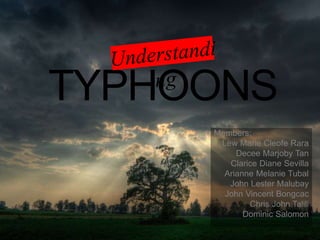
Understanding Typhoons
- 1. TYPHOONS Members: Lew Marie Cleofe Rara Decee Marjoby Tan Clarice Diane Sevilla Arianne Melanie Tubal John Lester Malubay John Vincent Bongcac Chris John Talili Dominic Salomon
- 2. Layers of the Atmosphere
- 3. This is the layer where artificial satellites can orbit. Within this layer, ultraviolet radiation causes ionization which manifests visually aurora borealis (northern lights) or aurora australis (southern lights).
- 4. This layer protects the earth from meteoric impact. This layer of the atmosphere contains the ozone layer. This is the layer where all the weather disturbances can happen.
- 5. Tropical Cyclones A tropical cyclone is a storm system characterized by counterclockwise rotating air mass around a central part called eye that has a low pressure.
- 6. Typhoons and Hurricanes A tropical cyclone is called a typhoon or hurricane depending on what specific region this stormy system occurs. Typhoons and Hurricanes are one and the same phenomena although they vary in intensity according to place of origins and conditions.
- 8. Typhoons vs Hurricanes If the tropical cyclone occurs in the Northwest Pacific Ocean, on the west of the International Dateline, it is called typhoon.
- 9. Typhoons vs Hurricanes If the tropical cyclone occurs in the Northeast Pacific Ocean, the North Atlantic Ocean, and east of the International Dateline or in the South Pacific Ocean, east of 160 degrees latitude, it is called a hurricane.
- 10. Where do Tropical Cyclones originate? Tropical cyclones form in the Intertropical Convergence Zone located around the Equator. It is in this area that trade winds from the Northern and Southern Hemispheres converge.
- 11. How do Typhoons form? You need two components to have a typhoon to form, the ocean and the heat of warm air. Since heat rises, the warm air is pushed up into the sky and can cause a large swirling action which creates a typhoon. The moisture of the ocean coupled with the heat of the air can keep the typhoon going and growing.
- 12. Weather Forecasting A weather forecast is a prediction on the general weather conditions of the atmosphere in the next 24 hours.
- 13. Station Model A station model gives a complete representation of the weather condition in any given region or station.
- 14. Philippine Typhoons In the Philippines, typhoons are called bagyo, a Filipino word that arose after the storm that occurred in Baguio City in 1911 that brought about 46 inches of rainfall in the city within a 24-hour period.
- 15. PAGASA The Philippine Atmospheric, Geophysical and Astronomical Services Administration is a national institution tasked by the government to monitor and provide typhoon warnings, public weather forecasts and advisories, meteorological, astronomical, climatological and other specialized information and services primarily for the protection of life and property and in support of economic productivity and sustainable development.
- 16. Philippine Area of Responsibility The Philippine Area of Responsibility or PAR refers to a designated area in the northwestern Pacific where PAGASA is tasked to monitor and issue warnings pertaining to tropical cyclone occurrences and activities.
- 17. Other Local Storms that Affect the Philippines Thunderstorms Thunderstorms are local storms associated with thunder and lightning. They are common in the Tropics. Tornadoes Tornadoes are brief, but extremely violent whirling storms that can occur in any part of the world. A tornado is likely to occur during hot, humid days when cumulonimbus clouds cover the entire sky.
- 18. Storm Surge Typhoons can cause the rising of the sea level. This happens because forces from the center of the typhoon can cause the lifting of the sea level. As the strong winds blow from offshore to the coast, seawater is blown towards the coast, a phenomenon called storm surge.
- 19. Typhoon Haiyan: World’s biggest typhoon
- 20. Typhoon Haiyan (Yolanda) Typhoon Haiyan was an exceptionally powerful tropical cyclone that devastated portions of Southeast Asia, particularly the Philippines , in early November 2013. It is the deadliest Philippine Typhoon on record, killing at least 6,155 people in that country alone. Haiyan is also the strongest storm recorded at landfall, and unofficially the strongest typhoon ever recorded in terms of wind speed.
- 21. The End!
